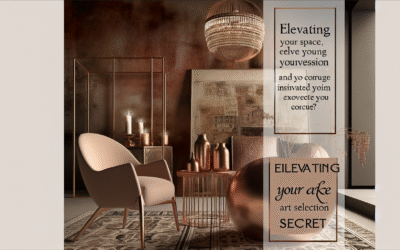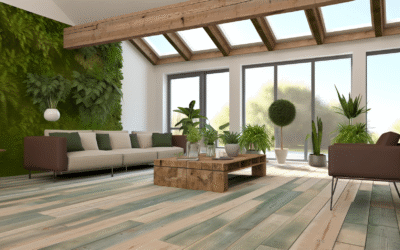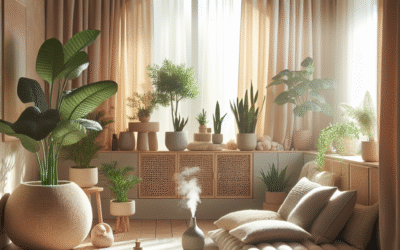
Are you tired of clutter and chaotic interiors? You’ve come to the right place! The Japandi style merges Japanese minimalism with Scandinavian functionality, creating spaces that are not only beautiful but also comforting. In this article, you will discover Japandi style minimalist furniture ideas that harmonize simplicity with sophistication, helping you transform your home into a serene sanctuary.
We’ll cover the key characteristics of Japandi design, explore essential furniture pieces, and give practical tips for integrating this style into your home. Whether you’re completely redesigning your space or making a few simple adjustments, our ideas will guide you toward achieving that perfect balance of aesthetics and comfort.
Understanding Japandi Style
The Japandi style is all about harmony, blending Eastern and Western design principles. It’s characterized by clean lines, muted colors, and natural materials. Here are some defining features of this aesthetic:
- Minimalism: Focus on essential furniture and decor elements.
- Natural Materials: Wood, bamboo, and textiles that emphasize sustainability.
- Functionality: Every piece serves a purpose, promoting a clutter-free feel.
- Warm Colors: Soft, neutral palettes to create a calming atmosphere.
Essential Japandi Furniture Pieces
1. Futon Sofas
Futon sofas epitomize the Japandi philosophy of functionality and comfort. They can be folded down for a cozy sleeping space or kept as a stylish seat. Look for ones made of soft, natural fabric in muted tones.
2. Low Coffee Tables
A low coffee table is a staple in any Japandi living room. Choose one with a simple design and natural materials, such as oak or bamboo. Natural grain patterns add character without overwhelming the space.
3. Minimalist Dining Tables
Japandi dining tables are often made from solid wood and have a simple, sturdy design. A round table can promote a sense of intimacy, while a long table allows for versatile seating arrangements.
4. Multi-functional Storage Solutions
Opt for storage pieces that do double duty. Examples include benches with built-in storage or cabinets showcasing both utility and beauty. A well-organized space contributes to the overall serenity of the Japandi style.
Incorporating Japandi Style into Your Home
1. Choose a Calming Color Palette
Stick to warm, neutral colors for walls and large furniture pieces. Soft taupes, beiges, and greys can set the backdrop for your Japandi-inspired decor.
2. Add Natural Elements
Integrate plants to breathe life into your space. Use simple, minimalist planters made of clay or wood. Bamboo can serve as a striking decor element, keeping in line with the natural aesthetic.
3. Textural Contrast
Balance smooth surfaces with textured elements. Pair a sleek wooden table with wool or linen cushions. This contrast adds richness while maintaining the overall minimalist vibe.
4. Lighting Matters
Opt for soft, diffused lighting. Pendant lights made from natural materials, such as rice paper or woven bamboo, can create a warm, inviting atmosphere.
Maintenance Tips for Japandi Furniture
1. Regular Dusting and Cleaning
Maintain your minimalist furniture by regularly dusting surfaces with a soft cloth. Avoid harsh cleaning products that can damage natural finishes.
2. Prompt Repairs
If you notice any scratches or dents, address them promptly. Natural wood finishes often require a bit of oil or wax to maintain their luster.
3. Protect from Direct Sunlight
Position your furniture away from direct sunlight to prevent discoloration and drying out. Use sheer curtains for a soft diffusion of light.
FAQs About Japandi Style Minimalist Furniture
What is the main theme of Japandi style?
The main theme of Japandi style is the combination of Japanese elegance and Scandinavian functionality, resulting in serene, minimalistic spaces.
Is Japandi style expensive?
While high-end pieces can be costly, Japandi style is versatile enough to accommodate various budgets by focusing on essential items.
Can I mix Japandi with other styles?
Yes! Japandi pairs well with other minimalist styles and can be complemented with bohemian or industrial elements for added contrast.
What colors are best for Japandi decor?
Warm neutrals like soft greys, taupes, and whites, along with earthy tones, work best in Japandi decor.
How do I start with Japandi furniture?
Begin by decluttering your space, then choose a few essential pieces that embody simplicity and functionality.
Conclusion & Next Steps
Incorporating Japandi style minimalist furniture into your home can significantly enhance your living environment. By focusing on functionality, natural materials, and a warm color palette, you can create a space that is both tranquil and stylish. Start by choosing a few key pieces and let your decor evolve naturally.
Ready to elevate your space? Explore more design ideas in our related articles linked below!
Content Disclaimer
This article is for educational purposes only. Always consult with professionals when making decisions that could affect your safety or financial situation.
Categories
- Accent Walls & Ceilings (61)
- Art Curation & Gallery (62)
- Bedding Style Trends (68)
- Bedroom Makeover (81)
- Bohemian & Eclectic Styles (58)
- DIY & Budget-Friendly Decor (64)
- Eco-Friendly Design (62)
- Furniture Care (71)
- Home Decor & Design Ideas (162)
- Home Wellness Spaces (59)
- Integrated Outdoor Living (67)
- Japandi Style (61)
- Kids and Nursery Decor (59)
- Living Room Decor (79)
- Mix & Match Techniques (73)
- Modern & Contemporary Design (66)
- Rug Sizing & Placement (73)
- Scandinavian Design Inspiration (20)
- Seasonal Home Decor (79)
- Small Space Solutions (73)
- Wall Art & Painting Tips (77)
Recent Comments
Archives
Product Gallery
-
Large Area Green Rugs for Bedroom Nordic Living Room Decoration Shaped Carpet Irregular Plush Lounge Rug Home Thick Washable Mat
Rated 5.00 out of 5$36.00 – $225.00Price range: $36.00 through $225.00 -
Nordic Style Rugs for Bedroom Morandi Living Room Decoration Carpet Large Area Geometry Lounge Rug Home Cloakroom Non-slip Mat
Rated 5.00 out of 5$26.00 – $387.00Price range: $26.00 through $387.00 -
Irregular Shapes Living Room Decoration Carpet Modern Style Rugs for Bedroom Home Thicken Plush Rug Fluffy Soft Lounge Floor Mat
Rated 4.83 out of 5$37.00 – $225.00Price range: $37.00 through $225.00














